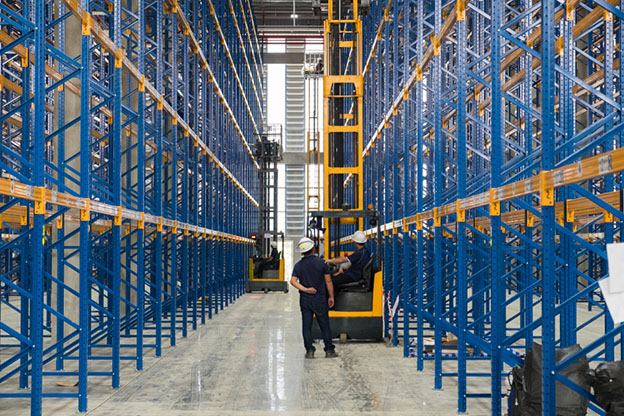Storage racks are the bread and butter of the warehousing industry. They keep your inventory organized so you and your colleagues can fulfill orders and get them out for delivery as fast as possible without damaging your products in the process. As ubiquitous as stack racks are within the warehousing and distribution industry, no two warehouses are exactly alike. Different facilities carry different products, and everyone has their own way of carrying out routine processes, such as getting products from the shelf to the loading dock.
Whether you’re starting a new business or you want to upgrade your warehouse racking system, learn more about how to find the best racking system for your facility in order to keep your inventory safe and organized every step of the way.
Identify Your Storage Needs
The first step is to identify your storage needs and come up with a plan in terms of storing your products and goods. Consider the item retrieval process for your facility. Are you grabbing boxes, pallets or individual items from bulk containers? Studies show the warehousing industry tends to vary widely. Only 9 percent of distribution centers and warehouses handle only full pallet orders, compared to 46 percent that handle a mixture of pallets, cases, split cases and pieces. Take stock of your operations, the containers you use and proper inventory handling before investing in a new racking system.
Every type of container or pallet comes with its own handling recommendations. For example, if you need to grab pallets or boxes from the top shelf, you’ll need to use an order picker instead of a traditional forklift. If you’re working with different pallet sizes, you’ll need to invest in rack decking. Use heavy-duty pallet racks for bulkier items.
Go through your records to determine how much inventory you may need to keep on hand at any given moment. You should have plenty of space on your racks for a sudden increase in inventory. If not, you may want to consider additional off-site storage solutions.
Choosing between a FIFO vs. a LIFO system will also affect your storage needs. Consider the racking and retrieval processes when installing your racks. Do they need to be loaded from the front or the back for optimal efficiency?
You should also consider storage density. Tucking pallets and products deep inside your racks can lead to excess labor costs. Retrieving certain items may affect your bottom line if they are stored improperly. Consider how many items you’ll need to keep on hand when calculating rack density.
Consider Access and the Flow of Your Facility
Optimizing the flow of your facility will help you get your products out the door as quickly as possible. In addition to vetting your storage requirements, don’t overlook the fact that your employees need to move through the space safely as well. Leave enough room for lift trucks, if necessary. Drivers should have plenty of room to move in and out of racking lanes without colliding into your products or other employees.
Make sure your employees can quickly reach the top shelf without risking their health or safety.

Comply with Local, State and Federal Regulations
It’s important to be aware of certain regulations when designing the layout of your facility. Be aware of your seismic zone if you work in an area that’s prone to earthquakes. You should also be aware of all emergency exits. Give your workers plenty of space to evacuate the facility if an emergency should occur.
Be Aware of Lighting and Other Visibility Issues
You also need to keep your merchandise visible. Make sure spot checkers can easily identify the number of products on the shelf without having to use a forklift. Invest in proper lighting so your employees can easily scan and read the SKU barcode.
Choose a Reliable Manufacturer or Reseller
It’s always best to partner with a reliable racking system manufacturer or reseller. When you choose a quality seller, you’ll have more peace of mind knowing your racks will last the test of time. You may need help when operating or maintaining your racks, so make sure you have access to a customer service representative.
Stack racks are an excellent storage system for large and bulky items. Regardless of how you plan on using this equipment, do your research before installing racks in your facility. The more forethought and planning you put into this process, the better off your business will be.

